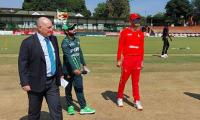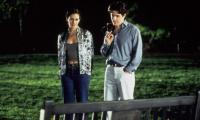VIENNA, Austria: “Vienna til I die!” chanted the fans, in accented English, at a recent rainy match, testament to the British roots of Austria’s oldest football club: the once-mighty First Vienna FC 1894.
But while the few hundred diehard supporters give it their all week in week out, the now dilapidated terraces of what was once continental Europe’s biggest stadium may soon fall silent for ever.
In March the 123-year-old club, which even under the Nazis was allowed to keep its English name “Vienna”, declared itself insolvent and is trying to hammer out a survival plan.
The players haven’t been paid since December and automatic relegation looms from Austria’s already lowly third division, the Austrian Regional League East, making finding new sponsors even harder.
“If it all ends, it will be the end of an era,” sighed Robert Haidinger, head of the supporters club, as he charged five euros ($5.50) for the trickle of cars arriving for the evening match.
“A piece of Viennese history would disappear,” he told AFP.
Like elsewhere in Europe and beyond in the late 19th century, British immigrants were a major driving force in the birth of Austrian football.
The “Vienna” was founded, in a pub, in 1894 by British gardeners together with locals smitten with this exotic new combination of exercise and gentlemanly “fair play”.
The club quickly became an all-Austrian affair but its three-legged logo, the triskelion, still survives in tribute to the homeland of one of the founders, William Beale from the Isle of Man.
To this day many of the chants on the terraces are in English. “Hey ho let’s go,” says a sign, in English, on the way out of the ground.
“To hear lots of voices singing all together something like ‘Come on Vienna’ is, well, it gives you goosebumps,” said Josef Keglevic, a lifelong fan.
“Vienna” used to be a force to be reckoned with not only in domestic football but internationally too. Visiting Spain in 1925, they thrashed Barcelona 4-1.
Its Hohe Warte stadium, the biggest in Europe outside Britain when it opened in 1921, was also the home ground for Austria’s legendary national “Wunderteam”.
As many as 85,000 supporters watched trainer Hugo Meisl’s men — slayers of allcomers and unlucky favourites for the 1934 World Cup — play Italy here in 1923.
In 1943 they won the Tschammerpokal cup at the since-renamed “Adolf-Hitler-Kampfbahn” stadium in Stuttgart.
After 1945, once Austria was re-established, the club remained highly successful and in 1955 won the Austrian championship for the sixth and, so far, final time.
Plagued by poor performances, a slow decline set in over the following decades and in 1992 it slipped out of the Bundesliga top league for the final time.
“The club also made a lot of mistakes,” Juraske said. “Financially it bit off more than it could chew.”
Chief executive Gerhard Krisch is trying to cut spending by 700,000 euros — a third of the club’s costs — but faces an uphill battle to save this piece of sporting history.
Regulations only allow the stadium — now a “nature arena” with a grass bank on three sides — to hold 5,500 people, stymying efforts to make money through events like concerts.
And in this small Alpine country, only the big clubs like Red Bull Salzburg can make any money, filling their stadiums with 15,000-20,000 fans.
“All the others have problems, including in the Bundesliga, with fewer than 2,000-3,000 supporters. That’s not enough to run a club economically,” Krisch told AFP.
But Josef Keglevic, a supporter since he was six years old, said “Vienna” still has something special.
“At clubs like Barcelona, Real Madrid or Bayern Munich... there is no humanity any more. There as a supporter you are just a number, a revenue generator,” he said. “But here there is something, a feeling... A soul, yes.”
Australian cricketer Phillip Hughes . — AFP/FileSYDNEY: Family and team-mates paid tribute to “infectious”...
Indian wrestler Bajrang Punia took part in protests against the Wrestling Federation of India last year. —...
An undated picture of Zimbabwe's all-rounder Sean Williams. — ICC/FileISLAMABAD: Zimbabwe all-rounder Sean Williams...
Pakistan's Shahnawaz Dahani and Ahmed Daniyal. — Instagram@idaniyal.latif/FileISLAMABAD: All-rounder Ahmed Daniyal...
Arsenal's Spanish coach Mikel Arteta hugs Arsenal's French defender William Saliba at the end of the UEFA Champions...
New Zealand's Tom Latham and England's Ben Stokes pose with the series trophy. — AFP/FileCHRISTCHURCH: New Zealand...







